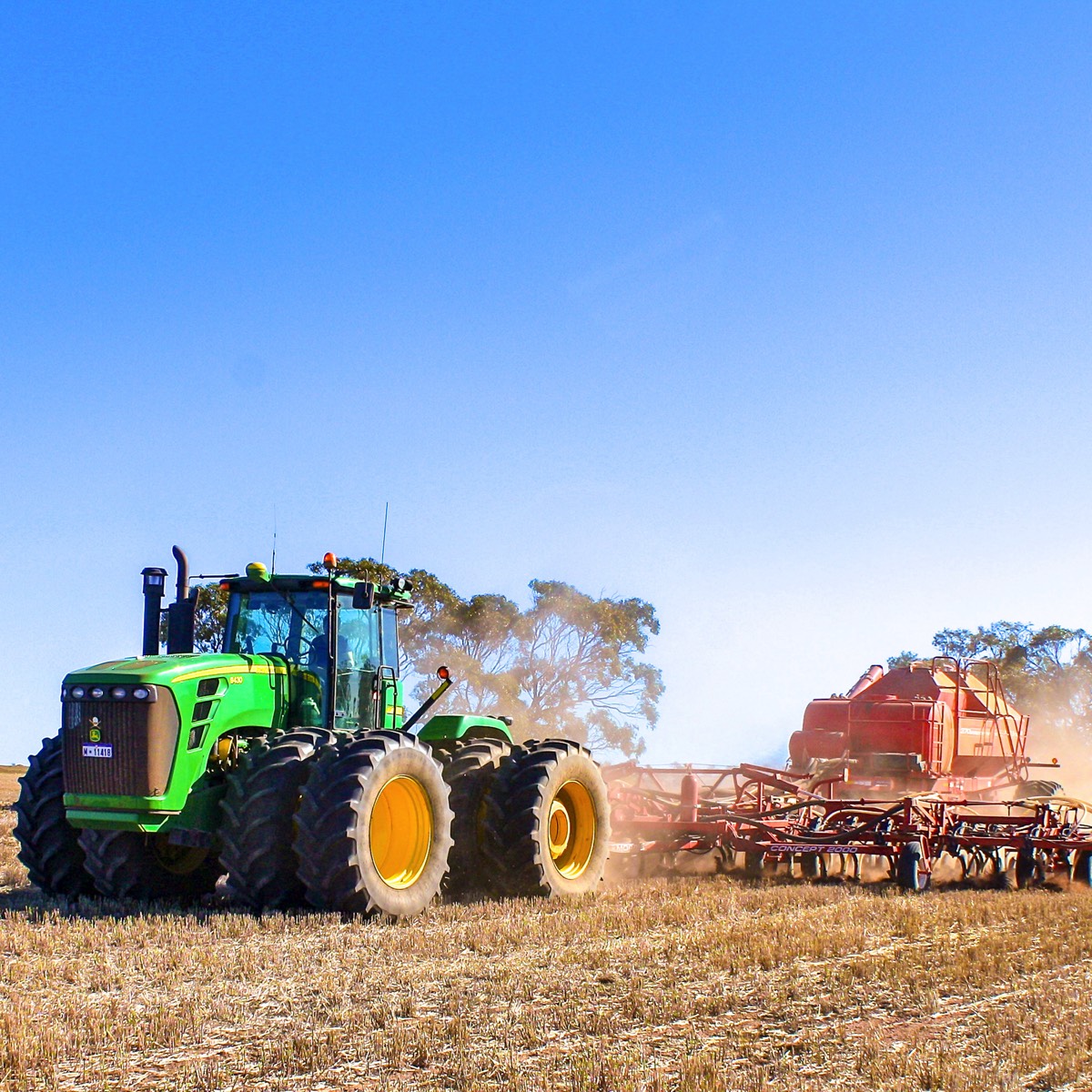Cranmore Park and Enterprises
Cranmore Park is home to 5700 hectares of beautiful rich soils ranging from red self-mulching clay through to loamy sands, with the dominant soil type being red-brown loam.
Cropping
The 4200-hectare dryland cropping program is comprised of a mix of wheat, canola, oats, barley, export hay and hay for on-property use.
In addition to traditional crops, clover regeneration is an ongoing project at seeding time.
In addition to traditional crops, clover regeneration is an ongoing project at seeding time.
Soil management and testing
The pH range of soils at Cranmore is from 4.7–7 (CaCl2). An extensive liming program carried out over the past five years has seen an increase in pH, with many paddocks now at the optimum pH of 5.5 (CaCl2). This is an ongoing project to ensure that soils are kept at their productive optimum pH and to protect against the acidification of soils so common in Western Australian cropping zones.
Soil testing is an integral part of both the cropping and pasture program at Cranmore. Soil testing allows measurement of soil nutritional status – 'If you can't measure the nutrients, how can you apply them appropriately?' – is a question soil testing aims to answer. Soil testing also dictates the need for lime application.
Soil testing is an integral part of both the cropping and pasture program at Cranmore. Soil testing allows measurement of soil nutritional status – 'If you can't measure the nutrients, how can you apply them appropriately?' – is a question soil testing aims to answer. Soil testing also dictates the need for lime application.
Integrated weed management
The onset of herbicide resistant weed populations in other areas of Western Australia lead to the development of an integrated weed management program at Cranmore to delay herbicide resistance for as long as possible.
The Cranmore integrated weed management program includes rotation of in-crop herbicides, use of a 'double knock' pre-seeding, livestock grazing over summer to prevent summer weed seed set, rotation of paddocks into pasture to allow for pasture manipulation and spray topping, cutting hay in problematic weed paddocks and introduction of canola to the rotation which allows for new groups of in-crop herbicides to be used.
The Cranmore integrated weed management program includes rotation of in-crop herbicides, use of a 'double knock' pre-seeding, livestock grazing over summer to prevent summer weed seed set, rotation of paddocks into pasture to allow for pasture manipulation and spray topping, cutting hay in problematic weed paddocks and introduction of canola to the rotation which allows for new groups of in-crop herbicides to be used.

Wheat

Wheat

Canola in full bloom
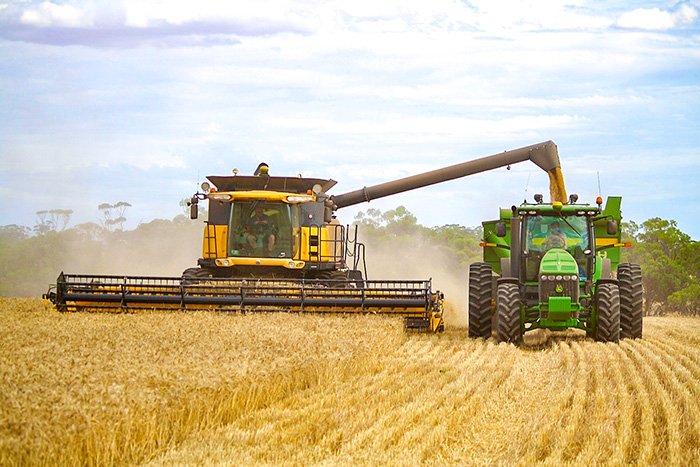
Wheat harvest
Cattle

Cranmore breeding herd
The cattle at Cranmore are predominantly Black Angus with some additional trade cattle as per seasonal feed opportunities.
A breeding herd consisting of 300 cows is the base of the Cranmore cattle herd. Most bull calves are contracted to the export market and leave the property at six to eight months, weighing in at 250–300 kilograms per head live weight. Steer calves tend to go to the local feedlot market at 200–250 kilograms per head live weight. Females are either retained for replacement breeding stock or sold at ten years of age.
Pregnancy testing is undertaken each year with dry cows sold immediately to maintain good fertility within the herd.
Drenching is rarely needed due to the good overall health of the cattle herd but is carried out where necessary.
A breeding herd consisting of 300 cows is the base of the Cranmore cattle herd. Most bull calves are contracted to the export market and leave the property at six to eight months, weighing in at 250–300 kilograms per head live weight. Steer calves tend to go to the local feedlot market at 200–250 kilograms per head live weight. Females are either retained for replacement breeding stock or sold at ten years of age.
Pregnancy testing is undertaken each year with dry cows sold immediately to maintain good fertility within the herd.
Drenching is rarely needed due to the good overall health of the cattle herd but is carried out where necessary.
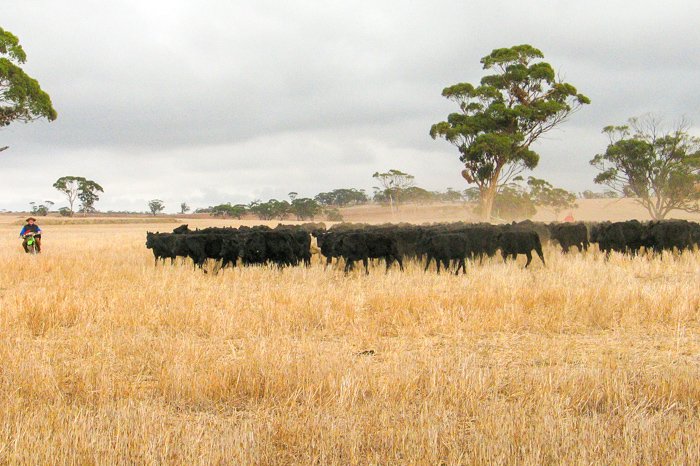
Cattle in stubble.
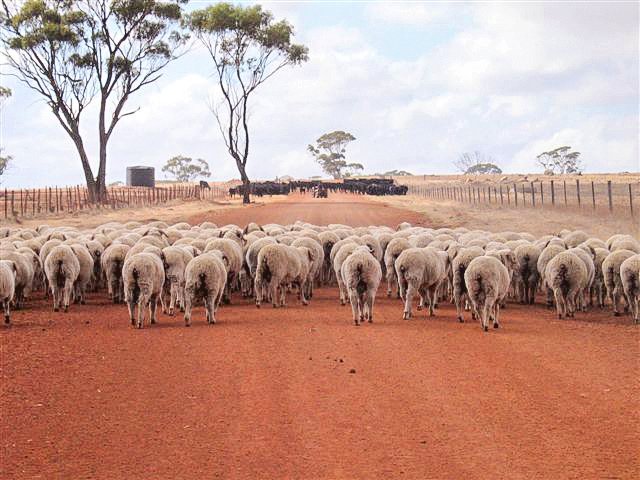
Stock being moved in early March.
Sheep
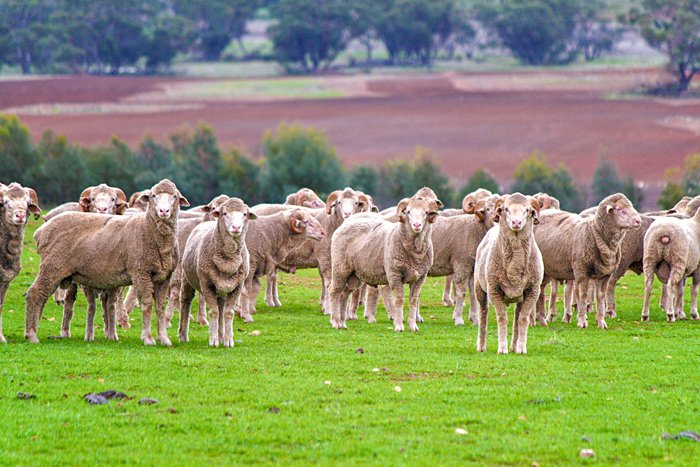
Cranmore stud flock.
The entire stud flock of Cranmore Merinos is run as a commercial flock, with all sheep being managed as per standard farm conditions. We believe this gives our clients the confidence to know that the rams they buy from Cranmore Merinos will perform as well for them as they do for us. We encourage clients to view our rams at our annual on-property field day and at the on-property ram sale each September. Stud ewes are also available for sale through private selection. For more information on either of these events please contact us.
The flock consists of 4000–5000 breeding ewes, including over 500 poll merino ewes. Each year 300–400 Cranmore Merino rams are sold through private selection and auction at the on-property sale.
Faecal egg counts are carried out on all sheep throughout the year to determine if drenching is necessary, in tandem with drench resistance tests. Resistance of sheep to infestation by worms is an increasingly important component of the breeding objectives for Cranmore Merinos.
All mated ewes are pregnancy tested for single and multiple lambs, to allow for additional feeding of pregnant ewes to ensure optimal nutrition of the ewe and growing lamb. This extra attention is part of the reason that Cranmore Merinos produce consistently high quality sheep; with good foetal nutrition having been proven to increase the primary to secondary follicle ratio resulting in finer, better aligned wool.
Want to know what's happening at Cranmore Merinos now? Go to News.
The flock consists of 4000–5000 breeding ewes, including over 500 poll merino ewes. Each year 300–400 Cranmore Merino rams are sold through private selection and auction at the on-property sale.
Faecal egg counts are carried out on all sheep throughout the year to determine if drenching is necessary, in tandem with drench resistance tests. Resistance of sheep to infestation by worms is an increasingly important component of the breeding objectives for Cranmore Merinos.
All mated ewes are pregnancy tested for single and multiple lambs, to allow for additional feeding of pregnant ewes to ensure optimal nutrition of the ewe and growing lamb. This extra attention is part of the reason that Cranmore Merinos produce consistently high quality sheep; with good foetal nutrition having been proven to increase the primary to secondary follicle ratio resulting in finer, better aligned wool.
Want to know what's happening at Cranmore Merinos now? Go to News.
Stocking rate
The two key profit drivers in livestock are stocking rate and cost efficiency. At Cranmore stocking rate is on the increase – increased stocking rate equates to higher profit margins per hectare. The goal for stocking rate is 9 dry sheep equivalents (DSE) per winter grazed hectare.
We believe that if Cranmore Merinos are run at a commercially high stocking rate in a stud situation, then our clients will also be able to achieve high stocking rates without compromising on individual performance of sheep or cattle.
We believe that if Cranmore Merinos are run at a commercially high stocking rate in a stud situation, then our clients will also be able to achieve high stocking rates without compromising on individual performance of sheep or cattle.
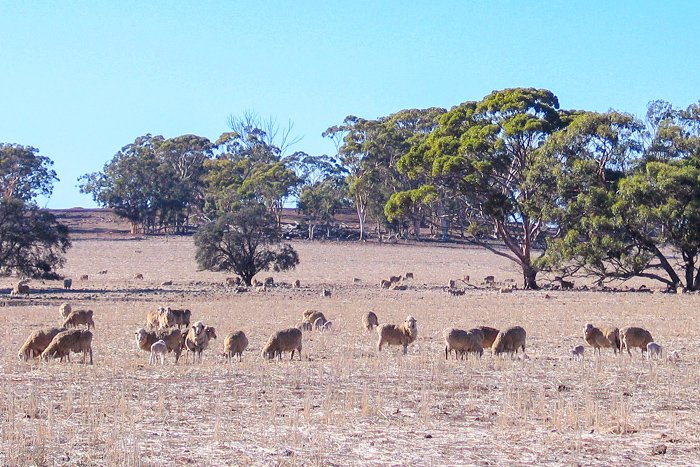
Ewes with their lambs.

Freshly weaned lambs onto an Oats fodder crop
Environmental Works
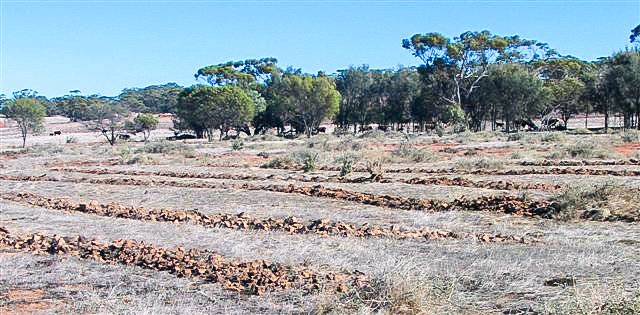
Revegetation of saline areas.
The long-term sustainability of Cranmore Park is paramount to the Lefroy family, with each generation aiming to leave the soil, water and overall environment in better condition than the last.
Tree planting is carried out in strategic zones of the farm to help manage underground water table movement, provide refuge for wildlife and act as windbreaks in erosion-prone areas. In 2005 alone, over 2000 trees were planted at Cranmore. All species are native to Cranmore Park, with some of the replanted trees being grown from on-property seed stock.
Tree planting is carried out in strategic zones of the farm to help manage underground water table movement, provide refuge for wildlife and act as windbreaks in erosion-prone areas. In 2005 alone, over 2000 trees were planted at Cranmore. All species are native to Cranmore Park, with some of the replanted trees being grown from on-property seed stock.

Tree lines growing.
Saltbush is also being planted on areas that are either prone to or endemically saline, with over 5000 plants sown in 2005. This program of planting saltbush was initiated over 50 years ago. Saltbush has the dual role of revegetating saline areas and providing an alternative summer-autumn feed source.
Federal government funding from the Natural Heritage Trust's EnviroFund has been utilised to fence off ridges of remnant vegetation. This remnant vegetation is again a haven for native fauna and flora.
Federal government funding from the Natural Heritage Trust's EnviroFund has been utilised to fence off ridges of remnant vegetation. This remnant vegetation is again a haven for native fauna and flora.

Mature tree lines.
Contact Us
Cranmore Farming Partnership
(formerly Boolardy Pastoral Co.)
Located at:
631 Cranmore Road, Bindi-Bindi, WA 6574
Mailing Address:
RSM 427 Moora WA 6510
Mr Kristin Lefroy
Mob: 0418 925 760
Email: kristinlefroy@cranmore.com.au
Conducting Agents
Nutrien Moora
Craig Williamson
Mob: 0429 813 988
-

Location map of Cranmore
Processing...
Cranmore Park, Moora, Western Australia





